Table of Contents
Medical disclaimer: This article is for informational purposes only and does not replace professional veterinary advice. Always consult your veterinarian for personalized guidance.
Leptospirosis can strike unexpectedly, even in the most pampered city pup. I’ve seen dogs that never leave their condo yards come in with fevers, kidney damage, and severe dehydration, all from an infection their owners didn’t know existed. In 2024, the dog leptospirosis vaccine will no longer optional. It’s a core protection every dog needs, regardless of lifestyle. This guide will walk you through the latest outbreak data, vaccine rules, and real risks, so you can make informed decisions for your pet’s health.
🐶 Key Takeaways: Dog Leptospirosis Vaccine in 2024
- The dog leptospirosis vaccine is now a core vaccine recommended for all dogs, regardless of breed or location, due to updated 2024 veterinary guidelines.
- Leptospirosis is a zoonotic disease (transmissible to humans) that can cause liver, kidney, or respiratory failure in dogs.
- Rodent exposure, flooding, and climate change have dramatically increased infection risks, even in urban areas.
- Annual boosters are essential because vaccine protection fades after 12–15 months and only covers four Leptospira serovars.
- Vaccination has become safer, with adverse reaction rates now comparable to those of rabies or distemper shots.
- Outbreaks in Canada and the U.S. show that most infected dogs were unvaccinated.
What Is Leptospirosis in Dogs?
Also visit: https://doglifeexpert.com/ibd-in-dogs-5-signs-its-not-a-food-sensitivity/
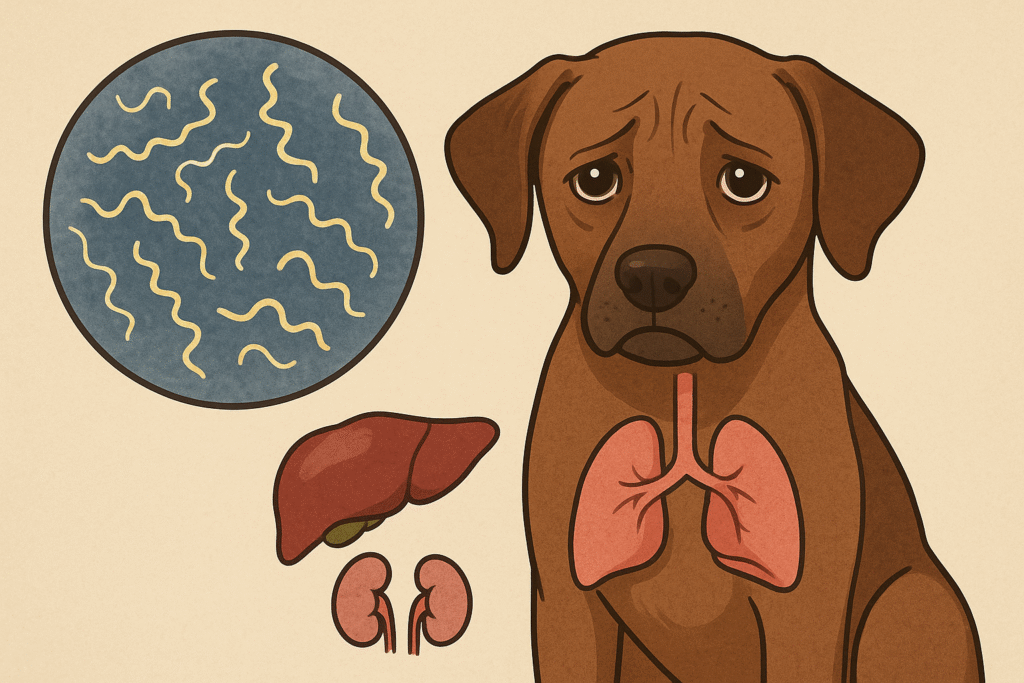
Leptospirosis is a bacterial infection that affects dogs and humans. It’s caused by spiral-shaped bacteria called Leptospira, which invade through mucous membranes or broken skin. Once inside the body, they rapidly spread to the kidneys and liver, and sometimes even to the lungs and central nervous system.
How It Spreads
Dogs typically become infected through contact with contaminated water, soil, or the urine of infected animals, especially rodents. Even sniffing a puddle where an infected rat urinated can be enough. In Canada, urban dogs exposed to city parks or alleyways face a surprising risk. This environmental route of transmission makes the dog leptospirosis vaccine a vital line of defense for every pet, not just farm or hiking dogs.
According to the CDC, the bacteria can survive for weeks in moist environments, especially after rainfall or flooding.
Symptoms to Watch For
Leptospirosis has a wide range of signs, from subtle to life-threatening. Common symptoms include:
- Lethargy and loss of appetite
- Vomiting and diarrhea
- Fever and muscle pain
- Jaundice (yellow gums or eyes)
- Increased thirst and urination (kidney involvement)
- Nosebleeds or coughing blood (in severe respiratory forms)
In my experience, early cases often look like a “just not right” dog with mild vomiting or fever. If caught late, hospitalization and aggressive IV therapy are often required. Prompt protection through the dog leptospirosis vaccine can prevent this scenario altogether.
Risks to Humans (Zoonosis)
Leptospirosis is zoonotic, meaning humans can contract it from infected dogs, particularly through urine exposure during cleaning or handling. This adds urgency to the vaccination conversation, not just for your dog’s health, but your family’s too. VCA Hospitals emphasize protective steps like handwashing, surface disinfection, and, most importantly, vaccination.
Why Leptospirosis Vaccine Is Now a Core Recommendation
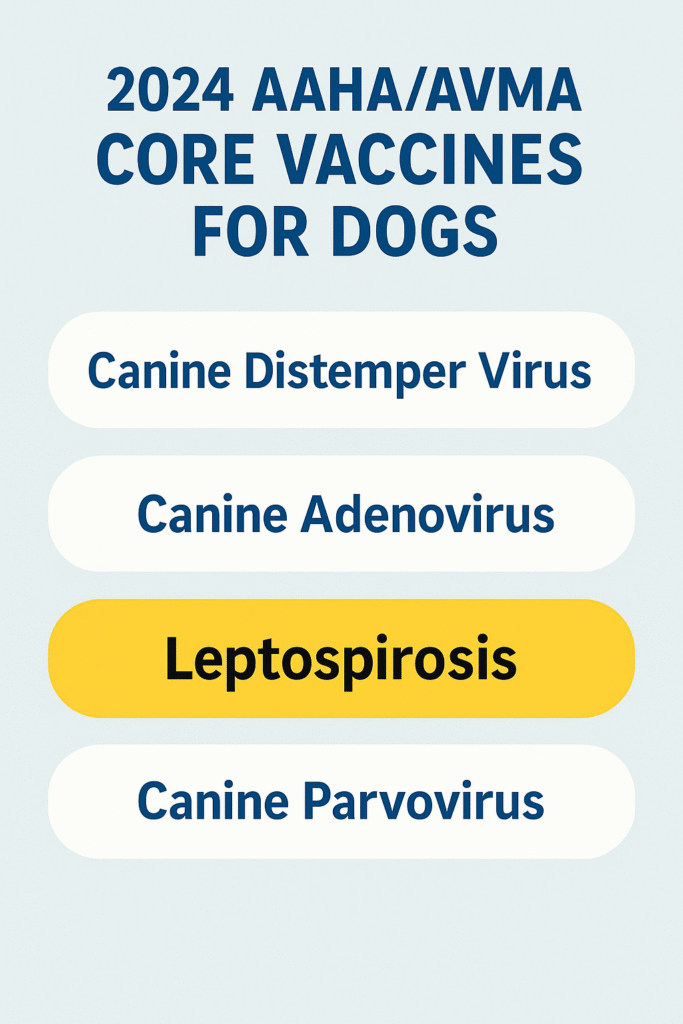
The shift in status for the dog leptospirosis vaccine isn’t just bureaucratic; it reflects real-world risk. As of 2024, leading veterinary organizations around the world have officially labelled this vaccine core, meaning it’s essential for all dogs, not just those considered “high risk.”
2024 Veterinary Consensus
In a joint update by the AVMA, AAHA, and WSAVA, guidelines now recommend:
- Initial vaccination at 12 weeks of age or earlier, depending on the product
- Two initial doses, 3–4 weeks apart
- Annual boosters for life
This new stance stems from growing evidence that all dogs are at risk, even those living indoors or in dry climates. Rodents don’t care if you live in a condo or on a farm; they’re everywhere.
What “Core Vaccine” Means
A core vaccine is one recommended for every dog, regardless of:
- Breed size (yes, even toy breeds)
- Indoor vs. outdoor lifestyle
- Region or climate
It’s on par with rabies and distemper-parvo in importance. In practice, this means that when you bring your dog in for their annual check-up, the dog’s leptospirosis vaccine should be automatically offered unless medically contraindicated.
Vaccine Duration & Serovar Coverage
The Leptospira vaccine typically protects against four major serovars:
- Icterohaemorrhagiae
- Canicola
- Grippotyphosa
- Pomona
However, immunity lasts only 12 to 15 months, another reason annual revaccination is non-negotiable. According to UC Davis, serovar coverage is incomplete, which means vaccinated dogs are not 100% immune but are significantly more protected.
Outbreak Trends & Risk Factors
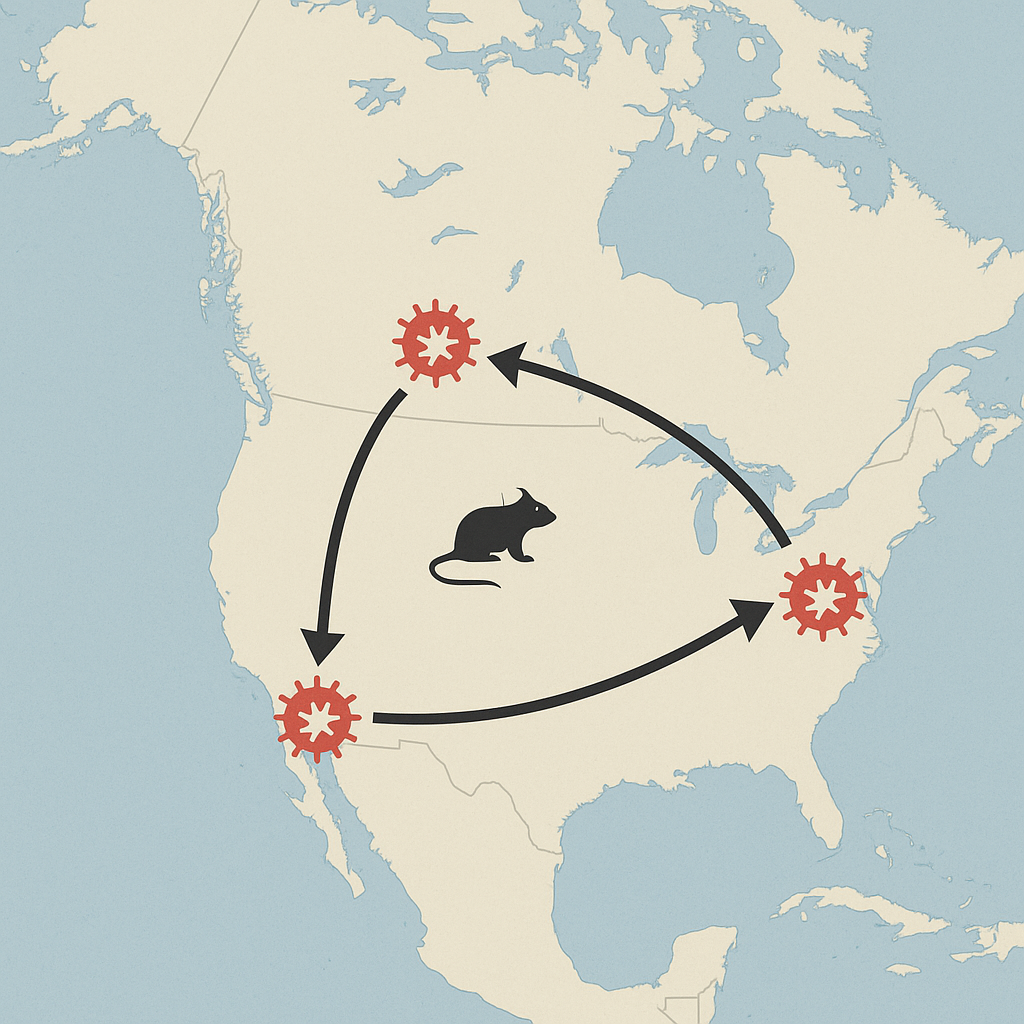
The urgency around the dog leptospirosis vaccine isn’t theoretical; it’s based on a surge in outbreaks across North America. What used to be considered a “rural farm dog disease” is now hitting suburban and urban dogs alike, often with deadly consequences.
Rodents and Urban Spread
Rodents, especially rats, are the primary carriers of Leptospira bacteria. Studies cited by the AVMA show prevalence rates as high as 80% in some urban rat populations. These animals contaminate parks, sidewalks, laneways, and even patios through their urine.
Living in Ottawa, I’ve treated city dogs never off-leash and mostly indoors, who ended up hospitalized after stepping in a contaminated puddle. The dog leptospirosis vaccine is one of the few reliable shields we have in this kind of silent exposure.
Rainfall, Flooding & Climate
Leptospirosis thrives in wet conditions. With climate change increasing both rainfall and flood events across Canada and the U.S., more dogs are exposed to contaminated runoff, soil, and standing water. According to the CDC, the bacteria can live in the environment for weeks, especially in warm, wet conditions.
Flooding after storms? That’s a hotspot. Dogs playing in yards or parks shortly after rain are particularly vulnerable, even if they’ve never left the city. These unpredictable exposures are why the dog leptospirosis vaccine is now strongly advised in both urban and rural areas.
Real-World Case Examples
- Cheyenne, Wyoming (Summer 2023): An outbreak predominantly affected unvaccinated dogs, with several requiring ICU care.
- New York City (Late 2023): According to the NYC Department of Health, nearly all dogs diagnosed with leptospirosis had not received the vaccine.
- Los Angeles (2022–2023): A ResearchGate study found that fewer than 25% of dogs seen by veterinarians were vaccinated, and fewer than 10% of pet owners were even aware of the outbreak.
Public Awareness Gaps
Despite updated guidelines, public awareness remains alarmingly low. Many dog owners mistakenly believe the dog leptospirosis vaccine is only necessary for dogs who swim or hike. The same 2023 ResearchGate study showed that vaccinated dogs were eight times less likely to require hospitalization after exposure.
Leptospirosis Vaccine Protocol: What to Expect
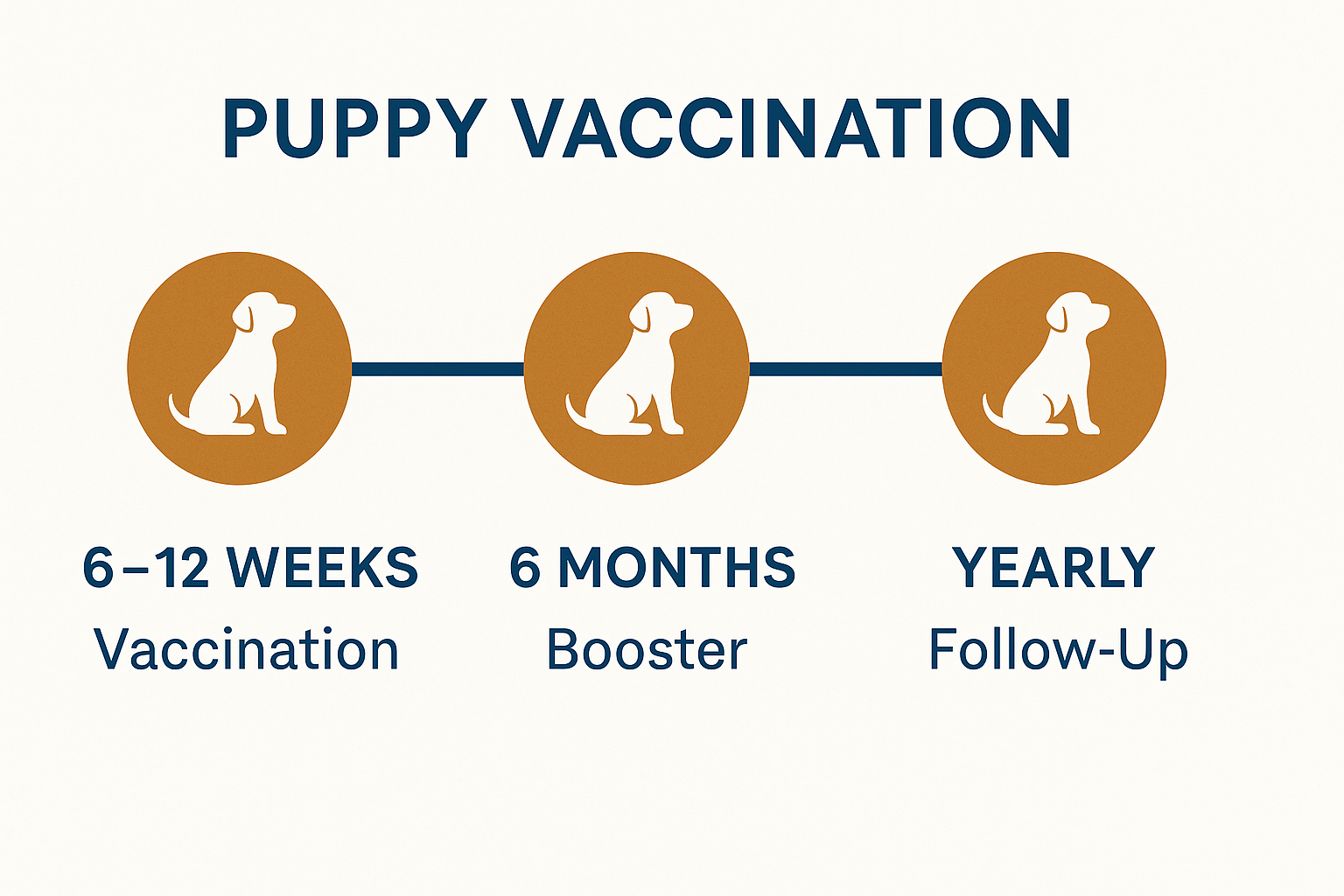
Getting your dog protected with the dog leptospirosis vaccine is straightforward, but the timing matters. Many cases I’ve seen involved well-meaning owners who either started too late or skipped the annual booster.
Puppy & Adult Dog Schedules
According to UC Davis, the vaccination protocol depends on age and vaccine brand:
- Puppies:
Start as early as 6 to 12 weeks (based on product label).
Requires 2 doses given 3 to 4 weeks apart. - Adult Dogs (unvaccinated):
Start with a 2-dose series, 3 to 4 weeks apart.
Immunity develops after the second dose. - Previously vaccinated dogs:
One annual booster is sufficient to maintain protection.
Booster Timing
Some veterinarians recommend a third dose at 6 months for puppies or higher-risk patients, especially during active outbreaks. The key is not missing the annual booster, as immunity wanes after 12–15 months. If a booster is overdue, your dog may need to restart the initial 2-dose series.
The AAHA guidelines emphasize that annual vaccination should continue for life, especially in areas where leptospirosis is endemic or outbreaks are frequent.
Safety & Side Effect Updates
Some owners worry about adverse reactions, especially for smaller breeds. While older vaccine formulations had higher side effect rates, modern leptospirosis vaccines are much safer. The VCA reports that side effect rates are now comparable to those for rabies and distemper/parvo vaccines.
Common mild side effects include:
- Soreness at the injection site
- Mild lethargy or reduced appetite for 24–48 hours
Serious reactions are extremely rare and often manageable in clinical settings. If you’ve ever hesitated about giving your small dog the dog leptospirosis vaccine, now is the time to revisit that choice with your vet.
How to Reduce Environmental Exposure
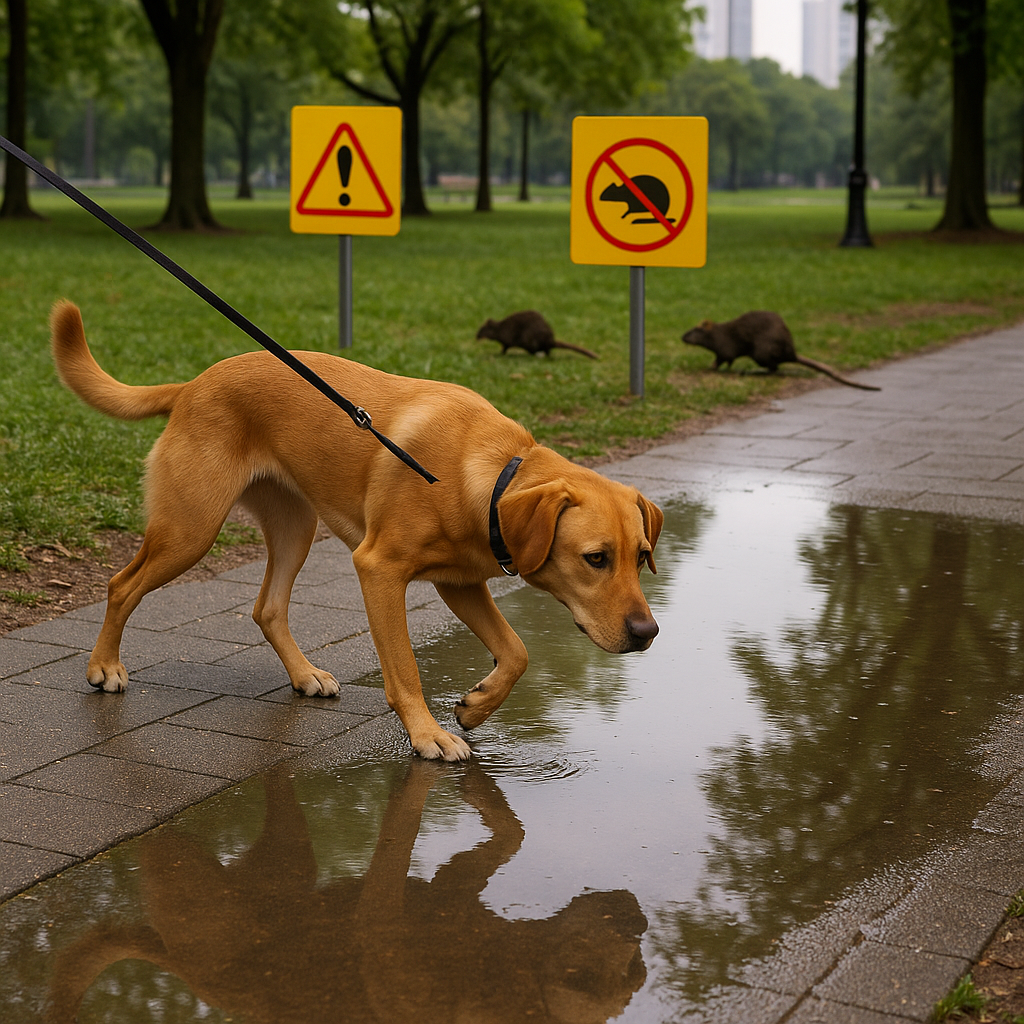
While the dog leptospirosis vaccine is the most effective form of protection, minimizing your dog’s exposure to contaminated environments is also essential, especially during wet seasons or in high-risk neighborhoods.
Rodent Control Tips
Rodents are the number one carrier of leptospirosis in urban and suburban areas. To reduce risk around your home:
- Keep garbage sealed and stored indoors or in rodent-proof bins
- Avoid feeding pets outdoors
- Eliminate birdseed spills and compost piles that attract rats
- Seal gaps in fences, sheds, and garage doors
- Use safe pest control measures, especially in basements or laneways
The AVMA emphasizes environmental cleanliness as a critical part of leptospirosis prevention. These precautions are most effective when combined with the dog leptospirosis vaccine, which offers immune protection against the bacteria rodents leave behind.
Safe Outdoor Practices
Leptospira bacteria thrive in puddles, wet soil, and stagnant water. During walks or off-leash playtime:
- Avoid areas with visible standing water
- Keep your dog leashed near alleyways or construction sites
- Clean paws with pet-safe wipes after wet walks
- Prevent dogs from drinking from puddles, ditches, or unfiltered outdoor sources
In my Ottawa practice, I’ve advised clients to use rain boots or paw covers for high-risk dogs during early spring and fall when rain is frequent. Even for vaccinated dogs, avoiding direct environmental contact further reduces the likelihood of infection.
Advice During Rainy Seasons
According to the CDC, heavy rainfall and flooding significantly increase transmission risk. During these periods:
- Avoid dog parks or trails with poor drainage
- Schedule indoor enrichment or playtime on wet days
- Delay hikes or cottage trips until conditions dry up
These lifestyle strategies, paired with routine administration of the dog leptospirosis vaccine, form the foundation of a comprehensive prevention plan.
Even vaccinated dogs are not 100% immune, especially if exposed to non-vaccine-covered serovars. So while the dog leptospirosis vaccine offers vital protection, combining it with common-sense exposure prevention is your best strategy.
FAQs About the Leptospirosis Vaccine
These are some of the most common questions dog owners ask me in the clinic, answered clearly and based on the latest evidence.
1. Does my dog need the leptospirosis vaccine if we live in the city?
Yes. Urban environments are full of hidden risks, especially from rodents. City parks, laneways, and even puddles near apartment entrances may be contaminated. The dog leptospirosis vaccine is now considered core for this very reason.
2. Is the leptospirosis vaccine safe for small dogs or puppies?
Modern vaccines have significantly improved. According to VCA, side effects are rare and usually mild. Tiny breeds may be monitored for 15–30 minutes post-injection for peace of mind, but overall safety is excellent.
3. Can the vaccine cause leptospirosis?
No. The dog leptospirosis vaccine is made from inactivated (killed) Leptospira bacteria, so it cannot cause disease. What it does is train the immune system to recognize and respond quickly if your dog is exposed.
4. My dog is indoor-only. Why vaccinate?
Indoor dogs can still be exposed via contaminated soil, tracked-in water, or even rodents inside homes or buildings. Outbreak studies, like one from ResearchGate, show that many affected pets had no known outdoor exposure.
5. How often should I repeat the leptospirosis vaccine?
After the two initial doses, your dog should receive one booster every 12 months. If a booster is missed by more than a few months, your vet may recommend restarting the series.
6. Will the vaccine protect against all strains?
The vaccine protects against the four most common serovars (types) of Leptospira, but not all of them. That’s why annual updates and environmental caution are still important. As the UC Davis guidelines note, breakthrough infections can still happen, though they tend to be less severe in vaccinated dogs.
Summary Table: Quick Care Checklist
This table breaks down the essentials of leptospirosis prevention for your dog vaccination timing, environmental safety, and owner awareness.
| Issue | Recommendation |
|---|---|
| Puppy vaccination | Start at 6–12 weeks, with 2 doses spaced 3–4 weeks apart |
| Booster schedule | Give the first booster at 6 months, then annually for life |
| Risk profile | All dogs are at risk, regardless of lifestyle or location |
| Environmental control | Practice rodent control; avoid puddles, wet soil, and standing water |
| Vaccine coverage | Covers 4 main serovars; not all strains |
| Side effect safety | Modern vaccines are safe, even for small breeds |
| Zoonotic protection | Prevents spread to humans, especially in families with kids or immunocompromised individuals |
| Veterinary review | Ask your vet for a yearly risk assessment during wellness visits |
Each of these measures, especially the dog leptospirosis vaccine, forms a layer of protection that, together, reduces your pet’s risk substantially.
Final Thoughts from a Canadian Veterinarian
Leptospirosis doesn’t care if your dog lives on a farm or in a condo. Over the past eight years of veterinary practice in Ottawa, I’ve treated cases that still haunt me, not because we didn’t act fast enough, but because the illness could’ve been avoided with a simple vaccine.
One case stands out vividly: a two-year-old terrier named Daisy. She never left the city, rarely walked off-leash, and lived in a spotless apartment. After a heavy rainfall in late September, she splashed in a puddle near a public park. Two days later, she came into the clinic lethargic and vomiting. Her kidney values were off the charts. Ultrasound revealed swollen, failing kidneys. We diagnosed her with leptospirosis, and she needed immediate hospitalization, IV fluids, and round-the-clock monitoring.
Daisy pulled through but just barely. Her owners were stunned. “She’s not even an outdoor dog,” they said. That’s when I began consistently urging every client, regardless of lifestyle, to update their dog’s leptospirosis status every year.
The 2024 AAHA and AVMA guidelines now make it official: the dog leptospirosis vaccine is a core vaccine, recommended for all dogs in all regions. This shift is grounded in hard data, from growing outbreaks to increased environmental persistence of the bacteria.
What I Recommend to Every Dog Owner:
- If your dog hasn’t started the vaccine series, don’t delay. Book that appointment this week.
- If it’s been more than a year, ask your vet whether a booster is overdue. Immunity fades faster than many realize.
- During rainy seasons, treat puddles like biohazards. Don’t let your dog drink from or walk through standing water, especially near dog parks or alleyways.
- Stay informed and ask questions. The more you know, the better decisions you’ll make for your dog’s health.
The dog leptospirosis vaccine is a small step with a massive payoff. It protects not only your pet but also your family, because leptospirosis is zoonotic. Treating leptospirosis can involve days in hospital, IV antibiotics, dialysis referrals, and in worst cases, euthanasia. Vaccination, by contrast, is a quick poke and a moment of discomfort.
You don’t have to wait for a scary story to act.
Vaccination is simple. Leptospirosis treatment is not.
By staying proactive, getting annual boosters, limiting environmental exposure, and spreading awareness, you’re doing more than protecting your pet. You’re also helping prevent the next outbreak.

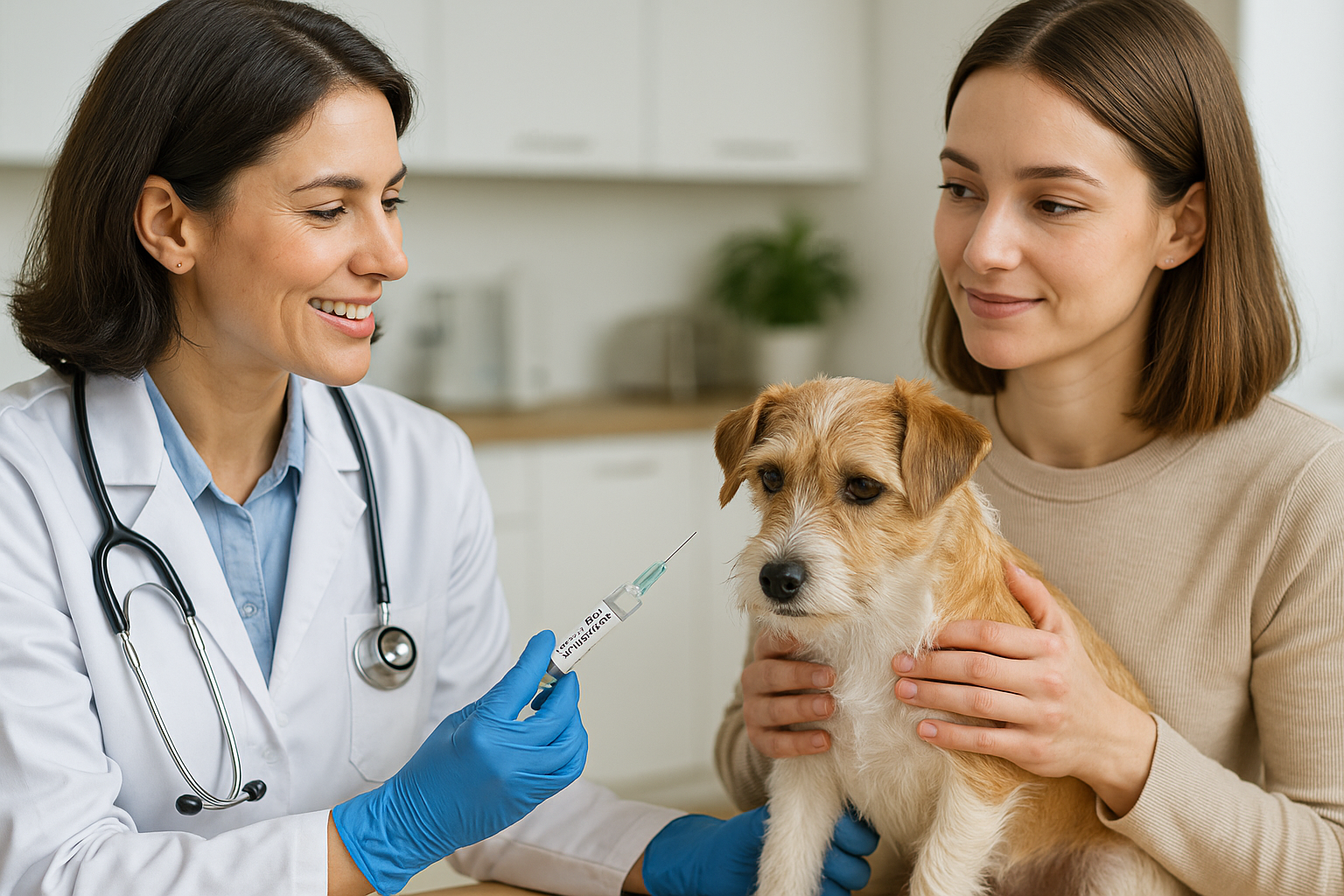
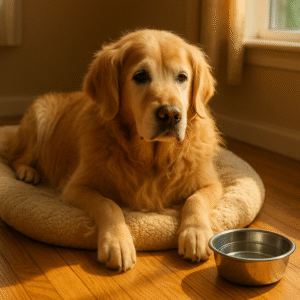
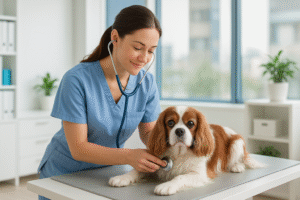

Pingback: 7 Shocking Reasons the Canine Parvovirus Threat Is Growing in 2025